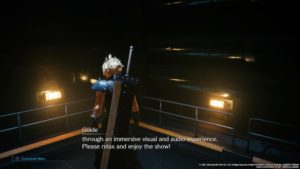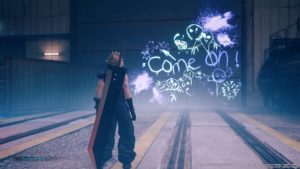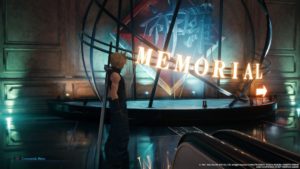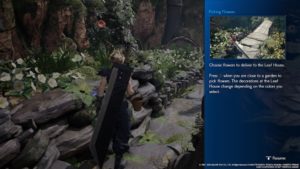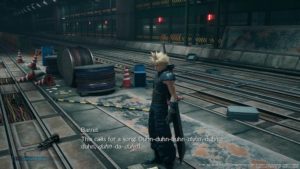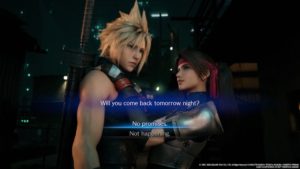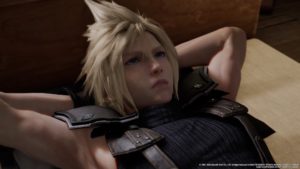I last played Final Fantasy VII when it came out originally. I liked the original, and probably count as a fan of the franchise generally, though my favorite iteration remains Final Fantasy VI, and I have slightly less experience with the modern action-leaning incarnations (X, XII, XIII, XV, and various spin-offs). Playing Final Fantasy VII Remake was probably the most sustained attention I have directed toward a video game in the past 10 years, taking about 40 hours total. While this may partly be due to the current shelter-in-place pseudo-quarantine context, it nonetheless speaks to the engaging spectacle and beauty of the reimagined Midgar. So keep that in mind as you read on. There may be spoilers throughout regarding the original FF VII storyline, as well as some spoilers near the end about the way the remake approached the material.
The original game was linear—almost all FF games are linear to some degree—and especially so during the initial Midgar sequence, which is the only material the remake covers, ending as Avalanche leaves the city. Since I started writing this review, I also played through the Midgar sequence of the original on Nintendo Switch, which took me about six hours, meaning the expansion/inflation is about sevenfold. Though lengthy for a prologue or tutorial section, the Midgar sequence works well in the original partly because the railroad feels subjectively like it opens up once the player finally reaches the overworld map and can begin to explore the mysteries of the Ancients and Sephiroth in a more self-directed manner (though this is somewhat illusory, as there are often a limited number of choices and a clear next step). In contrast, the Remake is one scene—quite literally—after another, leavened somewhat by numerous side quests (though many of the side quests are thematically weak “find lost cats” style collect tasks). The side quests seem inconsequential most of the time, and are limited to particular chapters. The strongest aspect of Remake is the visual care with which it was clearly constructed. In comparison to the original, the way the developers maintain and add detail to the original designs is impressive. Even putting aside the new plot elements—which I will discuss more near the end—the game aspect of Remake also has some shortcomings.
These gameplay shortcomings include some strange difficulty/balance issues, intrusive minigames, and confusingly modeful play. As a brief aside, Remake offers three difficulty modes: classic, easy, and normal. Hard mode becomes available after you beat the game. “Classic” is a nod to players desiring something closer to the original combat system. This is realized by replacing player controls with AI for basic attacks, dodging, and blocking, leaving the player to only select special moves and spells when the stamina bar (or whatever it is called) fills. Hard (which I have yet to try) only becomes available after beating the game; hard mode prevents the player from using items and makes rest areas only restore HP (no MP replenishment). Classic mode makes the combat much easier, rather than just changing the style, to the degree that it almost feels like cheating. I would say that the combat difficulty is moderate near the beginning of the game (probably easy for anyone even slightly better than me at action RPGs) and gets steadily easier. I defeated every boss on the first try except the Airbuster robot and the motorcycle sequence monster truck thing (which uses a different combat mode). So, the game has to be pretty easy, even on the highest difficulty mode available initially. I deferred to Classic mode twice early on, once with the rabid dog quest and once with the first Reno encounter (because he is twitchy AF). This is a long way around to say that the goal of FF7 Remake seems to be more sumptuous visual novel than gaming experience.
The minigames are either forgettable or mildly frustrating. Further, they tend to be separate from other gameplay skills and unique to the particular minigame, rather than building on previously developed skills. In the Remake’s defense, the minigames in the original are just as distracting (and far more prevalent than I remembered, even just limited to the small portion I replayed). However, the original generally has clearer breaks between game modes, allowing the player to easily predict how the game will behave, whereas in the remake gameplay, cut scene, minigame, and in-between modes blend together and functionality sometimes disappears or shifts confusingly. The Remake also has issues with communicating contingency to the player, by which I mean connection between what the player does and what happens in the game world. Sometimes it is unclear whether you are just pressing a button to advance or performing some skilled action. For example, I still have no idea whether Tifa’s progress in jumping chandeliers in the Shinra building had any connection to what I did with the controller, but I ended up with a keycard in the end so whatever. I suspect the Remake would be improved without most of the minigames. (It seems like the developers recognize this at some level, because one of the perks unlocked by beating the game is the ability to skip the motorcycle sequences when replaying chapters.)
The combat is satisfying, and fits the FF VII style, especially once you get the hang of some basic tactics. There is a slow motion, bullet time effect that occurs when you pause the action to issue commands, which is realized beautifully. Most of the strategic decisions involve distributing materia—the items that enable casting spells or using other abilities such as summoning—between characters. There is a subsystem with a separate experience point economy for upgrading weapons, but the choices seem hard to get wrong so the whole subsystem could probably have been automated and hidden from the player without loss.
Now I am going to discuss the Remake-specific aspects of the story. The game has a lot of potentially meta content, as in communication from developer to player directly rather than through storytelling, so much that it has to be intentional. Throughout the Remake, mysterious ghost things (“whispers”) intercede to shape the narrative, and while a final interpretation will need to wait on the next installment, it seems like the whispers will be an excuse to write a new plot going forward, especially given the final premature encounter with Sephiroth which, no matter the direction future games take, short-circuits some of the slow burn of discovering the nature and power of Sephiroth in the original game. The strange title and marketing also makes more sense in the context of future divergence; it is not Remake part 1 because part 2 will be a different story. I suspect the subtitles of future games will make this clear; perhaps the next installment will be called something like Final Fantasy VII Rebirth. The closest analogue to what I think the developers intend is the rebuild of Evangelion, the first installment of which roughly kept to the original anime. However, the second and third Evangelion Rebuild movies became steadily more baroque additions with new plots and characters.
The neo VII project more broadly—perhaps a series, perhaps a nascent “cinematic universe”—is ambitious and as yet unclear, though it seems from the signs in Remake that the creators are comfortable taking a demolitions approach to nostalgic fandom. While I have no trouble maintaining distance between the new and the old—after all, the previous game remains unchanged and cheaply available on many platforms—I suspect that many other fans feel differently, so this seems like a strange stance to take on the part of the developers. In total, the game was enjoyable and visually striking enough that I can see myself playing it again at some point, but as such a small portion of the original plot and with cumbersome retcon groundwork, Remake also feels like a opportunity missed.
(All images are screenshots I took during my play-through.)

